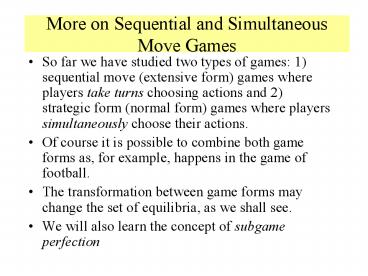More on Sequential and Simultaneous Move Games - PowerPoint PPT Presentation
1 / 15
Title:
More on Sequential and Simultaneous Move Games
Description:
More on Sequential and Simultaneous Move Games ... In some games, where both players have dominant strategies, it does not matter who moves first. ... games below it. ... – PowerPoint PPT presentation
Number of Views:217
Avg rating:3.0/5.0
Title: More on Sequential and Simultaneous Move Games
1
More on Sequential and Simultaneous Move Games
- So far we have studied two types of games 1)
sequential move (extensive form) games where
players take turns choosing actions and 2)
strategic form (normal form) games where players
simultaneously choose their actions. - Of course it is possible to combine both game
forms as, for example, happens in the game of
football. - The transformation between game forms may change
the set of equilibria, as we shall see. - We will also learn the concept of subgame
perfection
2
Combining Sequential and Simultaneous Moves.
- Consider the following 2 player game, where
Player 1 moves first - If player 1 chooses to stay out, both he and
player 2 earn a payoff of 3 each, but if player 1
chooses to enter, he plays a simultaneous move
game with player 2.
Player 1
Stay Out
Enter
3,3
3
Forward Induction
- The simultaneous move game has 3 equilibria
(A,A), (B,B) and a mixed strategy equilibrium
where both players play A with probability 1/3
and earn expected payoff 8/3. - If player 2 sees that player 1 has chosen to
Enter, player 2 can use forward induction
reasoning since player 1 chose to forego a
payoff of 3, it is likely that he will choose B,
so I should also choose B. - The likely equilibrium of the game is therefore
Enter, (B,B).
Player 1
Stay Out
Enter
3,3
4
The Incumbent-Rival Game in Extensive and
Strategic Form
How many equilibria are there in the extensive fo
rm of this game?
How many equilibria are there in the strategic fo
rm of this
game?
5
The Number of Equilibria Appears to be Different!
There appears to be just 1 equilibrium using
rollback on the
extensive form game.
There appears to be 2 equilibria using
cell-by-cell inspection of the strategic form game
6
Subgame Perfection
- In the strategic form game, there is the
additional equilibrium, Stay Out, Fight that is
not an equilibrium using rollback in the
extensive form game. - Equilibria found by applying rollback to the
extensive form game are referred to as subgame
perfect equilibria every player makes a perfect
best response at every subgame of the tree. - Enter, Accommodate is a subgame perfect
equilibrium. - Stay Out, Fight is not a subgame perfect
equilibrium. - A subgame is the game that begins at any node of
the decision tree.
3 subgames (circled) are all the games beginning
at all tree nodes including the root node (game
itself)
7
Imperfect Strategies are Incredible
- Strategies and equilibria that fail the test of
subgame perfection are called imperfect. - The imperfection of a strategy that is part of an
imperfect equilibrium is that at some point in
the game it has an unavoidable credibility
problem. - Consider for example, the equilibrium where the
incumbent promises to fight, so the rival chooses
stay out. - The incumbents promise is incredible the rival
knows that if he enters, the incumbent is sure to
accommodate, since if the incumbent adheres to
his promise to fight, both earn zero, while if
the incumbent accommodates, both earn a payoff of
2. - Thus, Stay Out, Fight is a Nash equilibrium, but
it is not a subgame perfect Nash equilibrium. - Lesson Every subgame perfect equilibrium is a
Nash equlibrium but not every Nash equlibrium is
a subgame perfect equilibrium!
8
Another ExampleMutually Assured Destruction
(MAD)
What is the rollback (subgame perfect) equilibr
ium
to this game?
A subgame
Another subgame
Subgames must contain all nodes in an informatio
n set
9
The Strategic Form Version of the Game Admits 3
Nash Equilibria
- Which Equilibrium is Subgame Perfect?
- Only the equilibrium where the strategies
Escalate, Back Down are played by both the U.S.
and Russia is subgame perfect. Why?
10
From Simultaneous to Sequential Moves
- Conversion from simultaneous to sequential moves
involves determining who moves first, which is
not an issue in the simultaneous move game. - In some games, where both players have dominant
strategies, it does not matter who moves first. - For example the prisoners dilemma game.
- When neither player has a dominant strategy, the
subgame perfect equilibrium will depend on the
order in which players move. - For example, the Senate Race Game, the Pittsburgh
Left-Turn Game.
11
The Equilibrium in Prisoners Dilemma is the Same
Regardless of Who Moves First
This simultaneous move game is equivalent to
either of the 2
sequential move games below it.
12
The Senate Race Game has a Different Subgame
Perfect Equilibrium Depending on Who moves first.
In the simultaneous move game, there is only one
Nash equilibrium.
subgame perfect eq,
subgame perfect eq,
13
Similarly, in the Pittsburgh Left-Turn Game
Driver 1
Driver 2
These subgame perfect equilibria look the same,
but if Driver 1 moves first he gets a payoff of 5
, while if Driver 2 moves first Driver 1 gets a
payoff of 5, and vice versa for Driver 2.
14
Going from a Simultaneous Move to a Sequential
Move Game may eliminate the play of a mixed
strategy equilibrium
- This is true in games with a unique mixed
strategy Nash equilibrium. - Example The Tennis Game
15
The Pure Strategy Equilibrium is Different,
Depending on Who Moves First.
There is no possibility of mixing in a sequential
move game without any information sets.































